POLYNESIA
117a
 Raphus cucullatus, Mergellus albellus
Raphus cucullatus, Mergellus albellusDodo and Smew from a 1627 painting misattributed to Jan Goeimare and Jan Davidszoon de Heem (actually by Gillis Claeszoon de Hondecoeter 1575/1580 1638, in the collection of Algernon Percy, 4th Duke of Northumberland, at Syon House. Probably a partial copy or derivative of de Hondecoeter's painting Perseus and Andromeda with a Dodo and seashells, and ultimately based on Roelant Savery's 1626 sketch of three dodos.
©: PDWikipedia
tags: #dodo #pacific ocean
117d
A Māori man and Joseph Banks exchanging a lobster for a piece of cloth, drawing by Tahitian chief Tupaia, c. 1769 (British Library) Photo: Public domain. Also on Nile & Clerk 1996
ref. # 043 Pacific Ocean -'The Parallel Lives of Paul Gauguin and Jacques Brel'
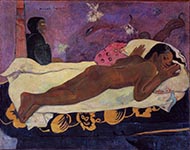 "Hidden within the depths of the Hiva Oa island in the Marquesas lie the tombs of two great artists - one a post-impressionist painter whose radical visual language would not be recognised until after his death; the other a Belgium-born singer-songwriter whose emotionally-charged performances made him one of the most popular French-language singers of all time."
"Hidden within the depths of the Hiva Oa island in the Marquesas lie the tombs of two great artists - one a post-impressionist painter whose radical visual language would not be recognised until after his death; the other a Belgium-born singer-songwriter whose emotionally-charged performances made him one of the most popular French-language singers of all time.""Paul Gauguin arrived in the Marquesas in 1891, having abandoned his family, business career and escaped angry creditors in Europe in pursuit of a life as an artist. Gauguin´s well-documented fascination with the Pacific grew from a disdain for European civilisation, which he considered to represent 'everything that is artificial and conventional'."
©: PD Wikipedia, Paul Gauguin. 'Spirit of the Dead Watching', 1892. Oil on canvas. Albright Knox Art Gallery.
More on Brell
tags: #Jacques Brell #Paul Gauguin
, ,
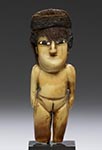 "Andean civilization is renowned for spectacular textiles that were at the heart of social politics and economics from earliest times. The fiber arts permeated all facets of daily existence, from clothing to protect the body to bridges spanning treacherous gorges. The form, materials, quality, and decorative imagery on clothing conveyed a person's social status or political affiliation and even recounted his or her specific accomplishments on behalf of the state. This female figure originally was dressed in clothing appropriate to her meaning as an offering - perhaps a building dedication cache or ritual deposit at a huaca, a sacred location where divine forces are concentrated. Coastal Andean peoples were keen observers of the vast ocean world. The Nazca, in particular, relied heavily on marine resources for food and materials for a variety of uses, such as the whale tooth from which this captivating lady was carved. The salty ocean and its unusual creatures constituted a dyadic opposition to the earth with its fresh waters. The carving of a ritual figurine from the tooth of a gigantic marine creature certainly carried extra spiritual significance. The authenticity of this figurine is now in question. Though the materials used are in keeping with those used by the ancient Nasca, recent discussions with scholars in the field in both United States and in Peru suggest that this type of figurine is not part of the known iconographic repertoire of the Nazca peoples of ancient Peru"
"Andean civilization is renowned for spectacular textiles that were at the heart of social politics and economics from earliest times. The fiber arts permeated all facets of daily existence, from clothing to protect the body to bridges spanning treacherous gorges. The form, materials, quality, and decorative imagery on clothing conveyed a person's social status or political affiliation and even recounted his or her specific accomplishments on behalf of the state. This female figure originally was dressed in clothing appropriate to her meaning as an offering - perhaps a building dedication cache or ritual deposit at a huaca, a sacred location where divine forces are concentrated. Coastal Andean peoples were keen observers of the vast ocean world. The Nazca, in particular, relied heavily on marine resources for food and materials for a variety of uses, such as the whale tooth from which this captivating lady was carved. The salty ocean and its unusual creatures constituted a dyadic opposition to the earth with its fresh waters. The carving of a ritual figurine from the tooth of a gigantic marine creature certainly carried extra spiritual significance. The authenticity of this figurine is now in question. Though the materials used are in keeping with those used by the ancient Nasca, recent discussions with scholars in the field in both United States and in Peru suggest that this type of figurine is not part of the known iconographic repertoire of the Nazca peoples of ancient Peru"
©: peruvian, possibly Nazca, Peru; CC The Walters Art Museum
tags: #nazca #peru #whale
ref. # 043a Pacific Ocean -Whale tooth female effigy figure
 "Andean civilization is renowned for spectacular textiles that were at the heart of social politics and economics from earliest times. The fiber arts permeated all facets of daily existence, from clothing to protect the body to bridges spanning treacherous gorges. The form, materials, quality, and decorative imagery on clothing conveyed a person's social status or political affiliation and even recounted his or her specific accomplishments on behalf of the state. This female figure originally was dressed in clothing appropriate to her meaning as an offering - perhaps a building dedication cache or ritual deposit at a huaca, a sacred location where divine forces are concentrated. Coastal Andean peoples were keen observers of the vast ocean world. The Nazca, in particular, relied heavily on marine resources for food and materials for a variety of uses, such as the whale tooth from which this captivating lady was carved. The salty ocean and its unusual creatures constituted a dyadic opposition to the earth with its fresh waters. The carving of a ritual figurine from the tooth of a gigantic marine creature certainly carried extra spiritual significance. The authenticity of this figurine is now in question. Though the materials used are in keeping with those used by the ancient Nasca, recent discussions with scholars in the field in both United States and in Peru suggest that this type of figurine is not part of the known iconographic repertoire of the Nazca peoples of ancient Peru"
"Andean civilization is renowned for spectacular textiles that were at the heart of social politics and economics from earliest times. The fiber arts permeated all facets of daily existence, from clothing to protect the body to bridges spanning treacherous gorges. The form, materials, quality, and decorative imagery on clothing conveyed a person's social status or political affiliation and even recounted his or her specific accomplishments on behalf of the state. This female figure originally was dressed in clothing appropriate to her meaning as an offering - perhaps a building dedication cache or ritual deposit at a huaca, a sacred location where divine forces are concentrated. Coastal Andean peoples were keen observers of the vast ocean world. The Nazca, in particular, relied heavily on marine resources for food and materials for a variety of uses, such as the whale tooth from which this captivating lady was carved. The salty ocean and its unusual creatures constituted a dyadic opposition to the earth with its fresh waters. The carving of a ritual figurine from the tooth of a gigantic marine creature certainly carried extra spiritual significance. The authenticity of this figurine is now in question. Though the materials used are in keeping with those used by the ancient Nasca, recent discussions with scholars in the field in both United States and in Peru suggest that this type of figurine is not part of the known iconographic repertoire of the Nazca peoples of ancient Peru"©: peruvian, possibly Nazca, Peru; CC The Walters Art Museum
tags: #nazca #peru #whale
117 Pacific - ´Tahiti,´
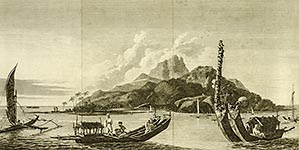 etching after ´Resolution´ and ´Adventure´ with fishing craft in Matavai Bay, painted by William Hodges in 1776, shows the two ships of Commander James Cook's second voyage of exploration in the Pacific at anchor in Tahiti.
etching after ´Resolution´ and ´Adventure´ with fishing craft in Matavai Bay, painted by William Hodges in 1776, shows the two ships of Commander James Cook's second voyage of exploration in the Pacific at anchor in Tahiti.©: PD
tags: #James Cook #Tahiti #Matavai Bay #resolution #Adventure
149 -Polynesian Navigation Aid
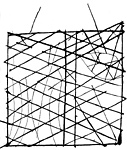 Polynesian navigation device showing directions of winds, waves and islands, c. 1904
Polynesian navigation device showing directions of winds, waves and islands, c. 1904"It has become clear that by 2500 years ago the peoples of Oceania had acquired the ability to build seaworthy outrigger canoes and to navigate thousands of miles using the stars, ocean currents and swells. Certainly some individuals who served as navigators had inborn capabilities similar to those possessed by migrating birds. Unfortunately modern civilization has destroyed these capabilities. However there still exist a few practitioners of this art. One of them is Mau Piailug, who was taught the ancient art by his grandfather. In 1976 he successfully navigated a Polynesian double-hulled canoe Hokule'a from Hawaii to Tahiti, without charts or any navigational instruments. Today, in his seventies, he is teaching young Polynesians the navigational arts at a school on the island Satawal in the Carolines."
This text ©: biega.com
"Polynesian navigation is a system of navigation used by Polynesians to make long voyages across thousands of miles of open ocean. Navigators travel to small inhabited islands using only their own senses and knowledge passed by oral tradition from navigator to apprentice, often in the form of song. In order to locate directions at various times of day and year, Polynesian navigators memorize important facts: the motion of specific stars, so where they would rise and set on the horizon of the ocean; weather and the seasons of travel; wildlife species (which gather at particular positions); the direction, size, and speed of ocean waves; colors of the sea and sky, especially how clouds would cluster at the locations of some islands; and angles for approaching harbours.
These wayfinding techniques along with their unique outrigger canoe construction methods have been kept as guild secrets. Generally each island maintained a guild of navigators who had very high status and in times of famine or difficulty these navigators could trade for aid or evacuate people to neighboring islands. As of 2014, the original methods of Polynesian navigation are still taught in the Polynesian outlier of Taumako Island in the Solomon Islands."
©: Public Domain Wikipedia
tags: #Polynesia #navigation aid #Mau Piailug
ref. # 149a -First settlers in Polynesia
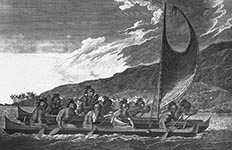 "The first Polynesian settlers arrived in the islands between 300 A.D. and 800 A.D. The circumstances of the first settlements of Hawaii are debated to this day (some believe there was an initial voyage from the Marquesas followed by a Tahitian invation in around 1300 A.D., whereas others argue there was only one longer period of settlement). There is no doubt however, that these first inhabitants navigated over a very large portion of sea during a time when the western world was barely daring to travel out of sight of the shore".
"The first Polynesian settlers arrived in the islands between 300 A.D. and 800 A.D. The circumstances of the first settlements of Hawaii are debated to this day (some believe there was an initial voyage from the Marquesas followed by a Tahitian invation in around 1300 A.D., whereas others argue there was only one longer period of settlement). There is no doubt however, that these first inhabitants navigated over a very large portion of sea during a time when the western world was barely daring to travel out of sight of the shore".©: www.mtholyoke.edu
tags: #Polynesia
,
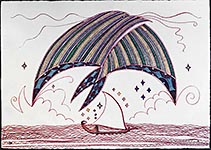 Drawing of a canoe with a white sail, above is the design of a large bird and several stars. It refers to the spiritual guardians of Polynesian navigators that may sometimes be stars or even birds. In this case the cloak has become a frigate bird. From Nga Tohunga Waka - The Navigator Series. 1993.
Drawing of a canoe with a white sail, above is the design of a large bird and several stars. It refers to the spiritual guardians of Polynesian navigators that may sometimes be stars or even birds. In this case the cloak has become a frigate bird. From Nga Tohunga Waka - The Navigator Series. 1993.
Pigment ink. Drawn by: John Bevan Ford
Made by Maori. Date 1991. Painted in: New Zealand (Oceania, Polynesia, New Zealand)
©: www.britishmuseum.org
tags: #Nga Tohunga Waka #British Museum #John Bevan Ford #New Zealand
149b -'The stars and the Frigate Bird'
 Drawing of a canoe with a white sail, above is the design of a large bird and several stars. It refers to the spiritual guardians of Polynesian navigators that may sometimes be stars or even birds. In this case the cloak has become a frigate bird. From Nga Tohunga Waka - The Navigator Series. 1993.
Drawing of a canoe with a white sail, above is the design of a large bird and several stars. It refers to the spiritual guardians of Polynesian navigators that may sometimes be stars or even birds. In this case the cloak has become a frigate bird. From Nga Tohunga Waka - The Navigator Series. 1993.Pigment ink. Drawn by: John Bevan Ford
Made by Maori. Date 1991. Painted in: New Zealand (Oceania, Polynesia, New Zealand)
©: www.britishmuseum.org
tags: #Nga Tohunga Waka #British Museum #John Bevan Ford #New Zealand

